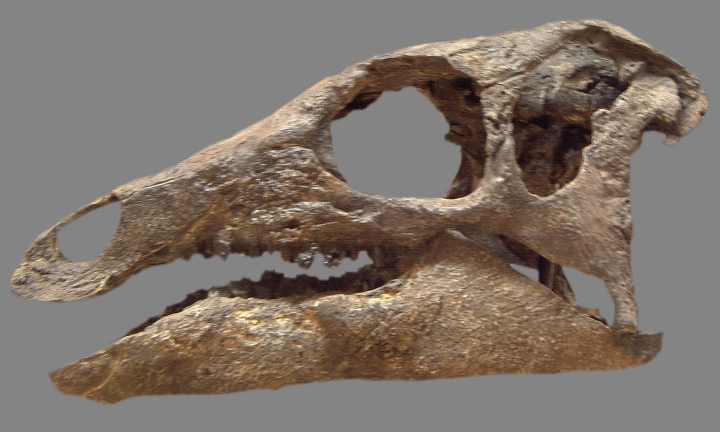- Camptosaurus
Taxobox
name = "Camptosaurus"
fossil_range=Late Jurassic

image_width = 200px
image_caption = Cast of a "Camptosaurus" skull fromBone Cabin Quarry West, Wyoming.
regnum =Animal ia
phylum = Chordata
classis = Sauropsida
superordo =Dinosaur ia
ordo =Ornithischia
subordo =Cerapoda
infraordo =Ornithopod a
familia =Camptosauridae
genus = "Camptosaurus"
genus_authority = Marsh, 1885
subdivision_ranks =Species
subdivision =
*"C. dispar" (Marsh, 1879 [originally "Camptonotus dispar"] ) (type)
*"C. aphanoecetes" Carpenter & Wilson, 2008
*?"C. hoggii" (Owen, 1874 [originally "Iguanodon hoggii"] ; shown by Carpenter and Wilson, 2008, not to be a "Camptosaurus")
*?"C. prestwichii" (Hulke, 1880 [originally "Iguanodon prestwichii"] )
synonyms=
*"Camptonotus" Marsh, 1879 "non" Uhler, 1864 (preoccupied)
*?"Brachyrophus" Cope, 1878
*?"Cumnoria" Seeley, 1888
*?"Symphyrophus" Cope, 1878"Camptosaurus" (pronEng|ˌkæmptəˈsɔrəs KAMP-to-SAWR-us) is a
genus of plant-eating, beakeddinosaur s of theLate Jurassic andEarly Cretaceous Periods. The name means 'bent lizard', because, when standing on all fours, its body must have been arched (Greek "καμπτος"/"kamptos" meaning 'bent' and "σαυρος"/"sauros" meaning 'lizard').Discovery and species
Originally described by O. C. Marsh in 1879 as "Camptonotus", or "bent back", it was renamed "Camptosaurus" in 1885 because the original name was already in use for a cricket. In 1879, Marsh named "C. dispar" (type species of the genus) and "C. amplus" for material he received from his collectors at Quarry 13 near
Como Bluff ,Wyoming . Throughout the 1880-1890s, he continued to receive specimens from Quarry 13 and named two additional species: "C. medius" and "C. nanus" based in part on size.Charles W. Gilmore named two additional species, "C. browni" and "C. depressus" in his 1909 [ cite book|title=Osteology of the Jurassic reptile "Camptosaurus", with a revision of the species of the genus, and descriptions of two new species|1909|author=Gilmore, C.W.|publisher=Proceedings, U.S. National Museum, vol. 36:197-302] redescription of the Marsh specimens. Then in 1980,Peter Galton and H.P. Powell in their redescription of "C. prestwichi" (see following), considered "C. nanus", "C. medius" and "C. browni" to be different growth stages or different gender of the larger "C. dispar", and therefore only "C. dispar" was the valid species. They also considered the skull referred to "C. amplus" by Marsh and by Gilmore to belong to "C. dispar", as well. Gilmore had used this skull to describe the skull of "Camptosaurus", but the specimen was recently shown by Brill and Carpenter [Brill, K. and K. Carpenter. 2007. A description of a new ornithopod from the Lytle Member of the Purgatoire Formation (Lower Cretaceous) and a reassessment of the skull of "Camptosaurus". pp. 49-67. In K. Carpenter, ed., 2007, Horns and Beaks: Ceratopsian and Ornithopod Dinosaurs. Indiana University Press, Bloomington.] not to belong to "Camptosaurus" and put it into its own genus and species, "Theiophytalia kerri". A second species of "Camptosaurus" was recently named by Carpenter and Wilson [Carpenter, K. and Wilson, Y. 2008. A new species of "Camptosaurus" (Ornithopoda: Dinosauria) from the Morrison Formation (Upper Jurassic) of Dinosaur National Monument, Utah, and a biomechanical analysis of its forelimb. Annals of the Carnegie Museum 76:227-263 [https://scientists.dmns.org/sites/kencarpenter/PDFs%20of%20publications/Carpenter_and_Wilson.pdf PDF] ] for specimens from Dinosaur National monument. It differs from "C. dispar" in the lower jaw, shorter neck vertebrae, and straighter ischium ending in a small "foot" among other features.While Marsh was describing "Camptosaurus" species in North America, numerous species from Europe were also referred to the genus in the late 1800s and early 1900s, as well: "C. inkeyi", "C. hoggii", "C. leedsi", "C. prestwichii", and "C. valdensis". "C. inkeyi" and "C. leedsi" consist of fragmentary material and species are no longer considered valid ("nomen dubium "). "C. valdensis" was moved to "Valdosaurus canaliculatus" by Galton in 1977 [Galton, P. M. 1977. The Upper Jurassic dinosaur "Dryosaurus" and a Laurasia-Gondwana connection in the Upper Jurassic. Nature 268(5617):230-232] . "C. hoggii" was originally named "Iguanodon hoggii" byRichard Owen in 1874 and was moved to "Camptosaurus" by Norman and Barrett in 2002 [ Norman D.B. and Barrett, P.M. 2002. Ornithischian dinosaurs from the Lower Cretaceous (Berriasian) of England. Palaeontology 68:161-189] .The remaining European species "Camptosaurus prestwichii" was recovered from Chawley Brick Pits,
Cumnor Hurst inOxfordshire in England. The fossil was found when a tramway was driven into the side of a hill. It was described by Hulke in 1880 as "Iguanodon prestwichii", and then placed in its own genus "Cumnoria " by Seeley in 1888. It was moved to "Camptosaurus" by Lydekker in 1889 where it remains today. [cite book|title=Fossil Reptiles of Great Britain|year=1995|author=Benton MJ, Spencer PS|publisher=Chapman & Hall|id=ISBN 0-412-62040-5] Theholotype skeleton (see picture) remains the best skeleton of "Camptosaurus" from Europe.Paleobiology
The largest adult camptosaurs were more than 7.9 meters long (26 ft), and 2.0 meters tall (6.7 ft) at the hips.cite book |last=Erickson |first=Bruce R. |authorlink=Bruce Erickson (paleontologist)|title=Dinosaurs of the Science Museum of Minnesota |year=2003 |publisher=The Science Museum of Minnesota |location=St. Paul, Minnesota |isbn=911338-54-3 |pages=33 ] They had heavy bodies but, as well as walking on four legs (
quadruped al), they could rear up to walk on two legs (biped al).This genus is probably closely related to the ancestor of the later
iguanodon tid andhadrosaur id dinosaurs. It probably atecycad s with its parrot-like beak.References
* [http://www.users.qwest.net/~jstweet1/iguanodontia.htm Iguanodontia at "Thescelosaurus"!]
Wikimedia Foundation. 2010.
